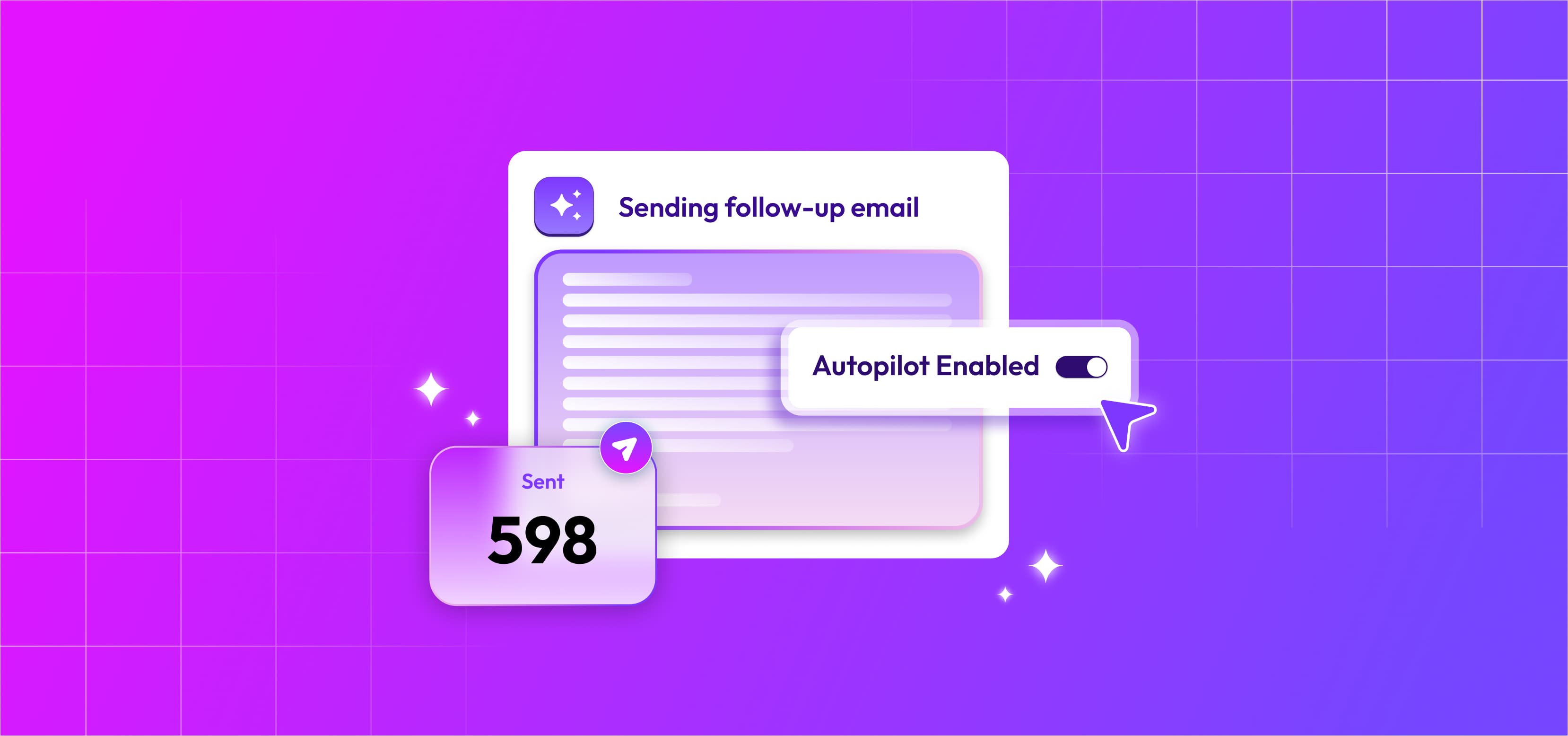Struggling to keep up with your sales operations? You could spend months looking for the perfect in-house sales assistant and still land the wrong candidate. Or, you could hire a virtual assistant.
A virtual sales assistant offers sales support to handle specific tasks or projects without a long-term commitment. It’s a quicker and cheaper option, and you can start or stop as needed.
Not sure where to begin? Try here.
Benefits of Hiring a Virtual Sales Assistant for Your Business
The global outsourcing market is booming. Here’s why.
It’s Cost-Effective
According to Glassdoor, the average total pay for a B2B sales rep is $117,000/year in the U.S., with a base salary of around $67,353/year.
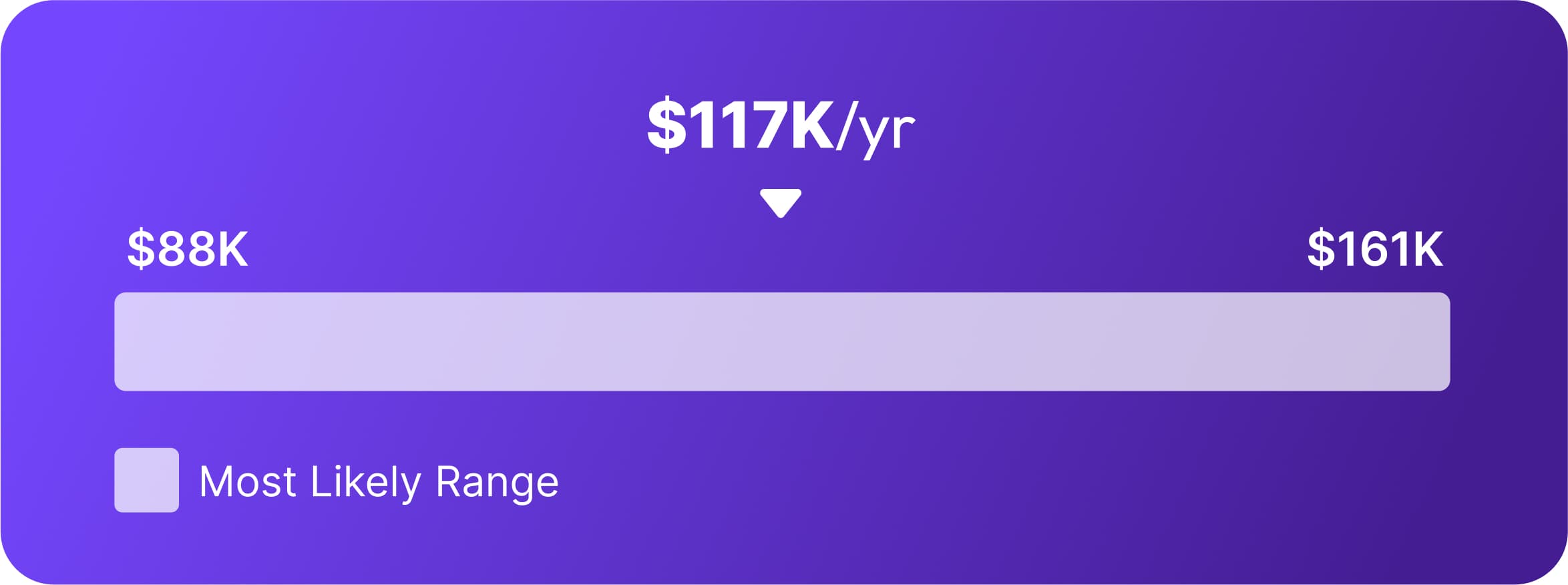
Assuming that companies don’t usually pay commissions to sales assistants, let’s only take the base salary to calculate the full-time sales hire’s hourly rate. This translates to roughly $35/hour for a full-time employee—and that’s before considering the benefit package, time off, and hiring costs.
In contrast, top part-time sales assistants typically charge significantly less—often half as much per hour. Here are the sample rates from a virtual assistant staffing agency:
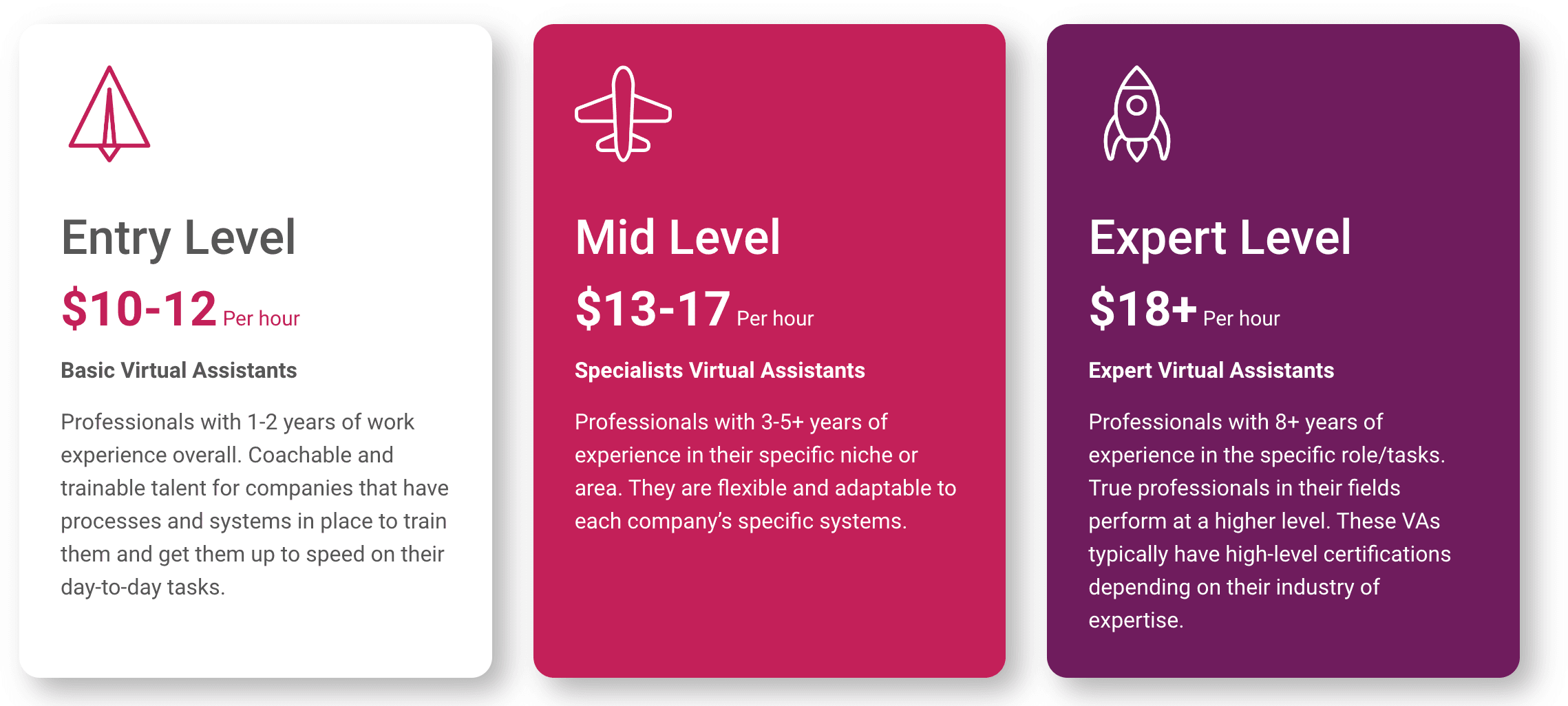
It’s Fast
The average time to fill a position in the U.S. is 44 days. In Europe, where labor laws are far stricter, companies spend even more time looking for an ideal candidate.
Hiring a virtual assistant is a perfect option when you need help here and now.
It Boosts Productivity
To boost your sales team’s performance, you don’t necessarily need a more experienced sales manager or additional SDRs. What you really need is to relieve your staff from time-consuming tasks so they can finally focus on high-value sales efforts.
Ironically, you’ll achieve better results by hiring an entry-level virtual assistant than by bringing on another sales rep only to be bogged down with administrative work.
It Fills the Gaps
Even the best teams can have skill gaps as new tech and needs pop up. Closing those gaps with full-time employees can be expensive, as we’ve seen.
A virtual sales assistant can provide the expertise or capabilities your team is missing. Whether it’s setting up analytics or reaching out to leads in a different time zone, the right virtual assistant can handle these without the costs and implications of hiring a new team member.
It’s Flexible
Imagine you’re launching a new branch and need to quickly source thousands of leads to start outbound sales. Or maybe you’re testing a new strategy and aren’t sure if it will last beyond a few months. Once the project ends, you could be left with an extra team member—or worse, have to let a brand new hire go.
Virtual assistants offer the flexibility to run experimental projects and temporarily boost your team’s capacity. If the project proves successful, you can always decide to hire a full-time employee later. It’s a smart way to assess your real business needs before making a full commitment.
What to Consider When Hiring a Virtual Sales Assistant
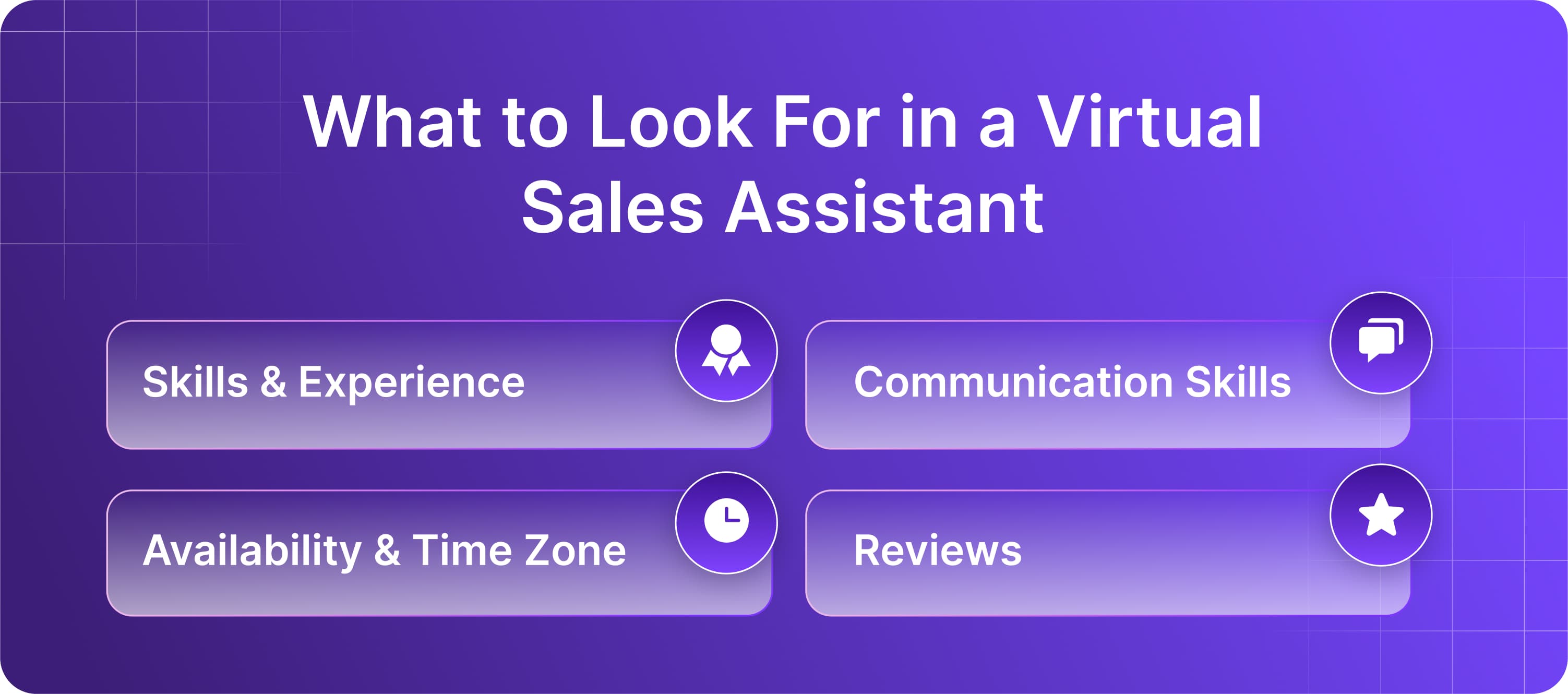
There are thousands of virtual sales assistants available for hire. What should you be looking for in your candidate?
1. Skills and Experience
Even if you’re hiring an assistant for undemanding tasks, it’s still important they have relevant experience in the work you need done.
Look for candidates who can share examples of successful projects they’ve completed or demonstrate their experience in other ways, such as explaining the processes and tools they typically use for similar tasks.
Later in the article, we’ll share some tips on how you can test your virtual sales assistants without going through a full hiring process.
2. Availability and Time Zone
Figure out the best working hours for your future assistant and whether you need an overlap with your team’s schedule to keep communication smooth.
Depending on the tasks, your virtual assistant might need to work the same hours as your team—or not. For example, if they’re handling admin tasks like organizing CRM data, it’s helpful if they can reach out to your team when needed and vice versa.
But if they’re doing something like cold calling or customer support in a different time zone, you’ll obviously want them working while your team is off the clock.
3. Communication Skills
You’d think everyone has solid communication skills these days—but that’s far from true. Over half of knowledge workers (51%) have experienced increased stress at work due to poor communication.

You might not realize how important good communication is until you’re dealing with someone who ghosts you, leaves out key details, or fails to follow up, which is way too common with contractors.
This is arguably more important than industry-specific expertise. A motivated person with strong communication skills can quickly learn new tasks and deliver great results, while someone who struggles to communicate clearly can cause major project delays.
4. Reviews
If a candidate can share positive testimonials from previous clients, that might be all you need to make your decision.
Reviews often reveal more than the candidate themselves can, and they do so more objectively. When hiring through a freelance platform like Upwork, you can easily check a candidate’s past jobs, overall rating, number of completed projects, and real client reviews for each job.
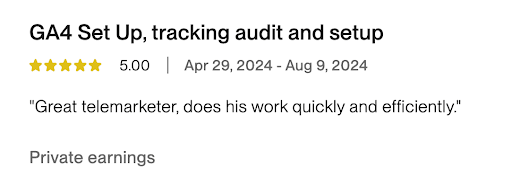
Top-rated candidates will understandably cost more, but your positive experience is worth the extra expense.
What Does a Virtual Sales Assistant Do?
Here are the tasks companies usually hire virtual sales assistants for.
1. Lead Generation & Nurturing
The most common task companies outsource to virtual sales assistants is outbound demand generation. It’s labor-intensive, time-consuming, and, for the most part, doesn’t require any specific skills.
Virtual sales assistants usually tackle one or several aspects of the process, such as:
Finding leads based on predefined criteria.
Enriching lead profiles with relevant data.
Sending LinkedIn connection requests.
Updating the lead database with new information.
Personalizing and sending cold outreach messages.
Making cold calls.
Do these sound like activities you’d like to offload? Great, but you don’t actually need a human assistant for these tasks anymore.
AI assistants can do the same work, but faster, with better quality, and at a lower cost. From a total of 74% of sales pros who have already adopted AI tools and bots, one in four experts use it for lead generation and outreach.
For instance, Ava, an AI-powered sales assistant can automate 80% of the outbound demand generation process. To do so, she:
Listens to your requirements;
Searches the database of 300M B2B leads;
Finds the ones that fit your ideal customer profile (ICP);
Crafts personalized outreach emails for each of them;
Launches follow-up sequences for leads who haven’t responded to the first message;
Continuously optimizes her messaging based on response rates.

Ava outperforms a whole team of human assistants and doesn’t charge by the hour. Hire Ava today!
2. Customer Follow-Ups
Keeping up with customer relationships can be a lot of work, but a virtual sales assistant can take a huge chunk off your plate. Here’s how they can help:
Sending follow-up emails or messages to keep in touch with customers.
Scheduling and reminding customers about upcoming appointments or calls.
Updating customer details and interactions in your customer relationship management (CRM) system.
Handling questions or concerns that pop up.
Tracking ongoing deals and nudging leads.
Chasing lost opportunities.
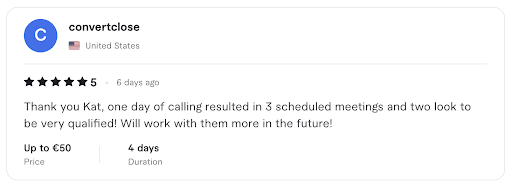
Once again, AI assistants are stepping in to handle these tasks, and it’s just a matter of time before all your competitors start using technology for follow-ups. By 2028, 60% of B2B seller work will be done through conversational interfaces via GenAI sales technologies, up from less than 5% in 2023.
But here's the catch: someone still needs to manage these AI tools. The data shows that 35% of Chief Sales Officers (CSOs) plan to establish a dedicated “GenAI Operations” team as part of their go-to-market (GTM) strategy in the next year. So, instead of looking for a virtual assistant to manage follow-ups manually, consider hiring one to manage your AI workflows. It’s the next step forward.
3. Appointment Scheduling
A virtual sales assistant can tackle everything from demo bookings to sales reps’ calendar management. You can entrust them with:
Scheduling and streamlining mestings with potential customers.
Coordinating between different time zones.
Setting up reminders and follow-ups to ensure no one misses an important call.
Handling last-minute changes or cancellations.
Basically, it’s like having a secretary manage your and your team’s schedule, but without having them sit in your office space. If you’ve been struggling to keep up your calendar and resolve schedule conflicts, hiring a virtual sales assistant is the way to go.
4. Sales Pipeline Management
Managing a sales pipeline can get messy, especially when you’re juggling multiple leads at different stages. A virtual sales assistant can help keep everything organized and on track by:
Monitoring and updating leads as they move through the sales funnel.
Keeping your CRM organized by ensuring all prospect information is up-to-date and properly categorized.
Setting reminders for follow-ups, so no lead slips through the cracks.
Generating reports to give you a clear view of your pipeline’s health.
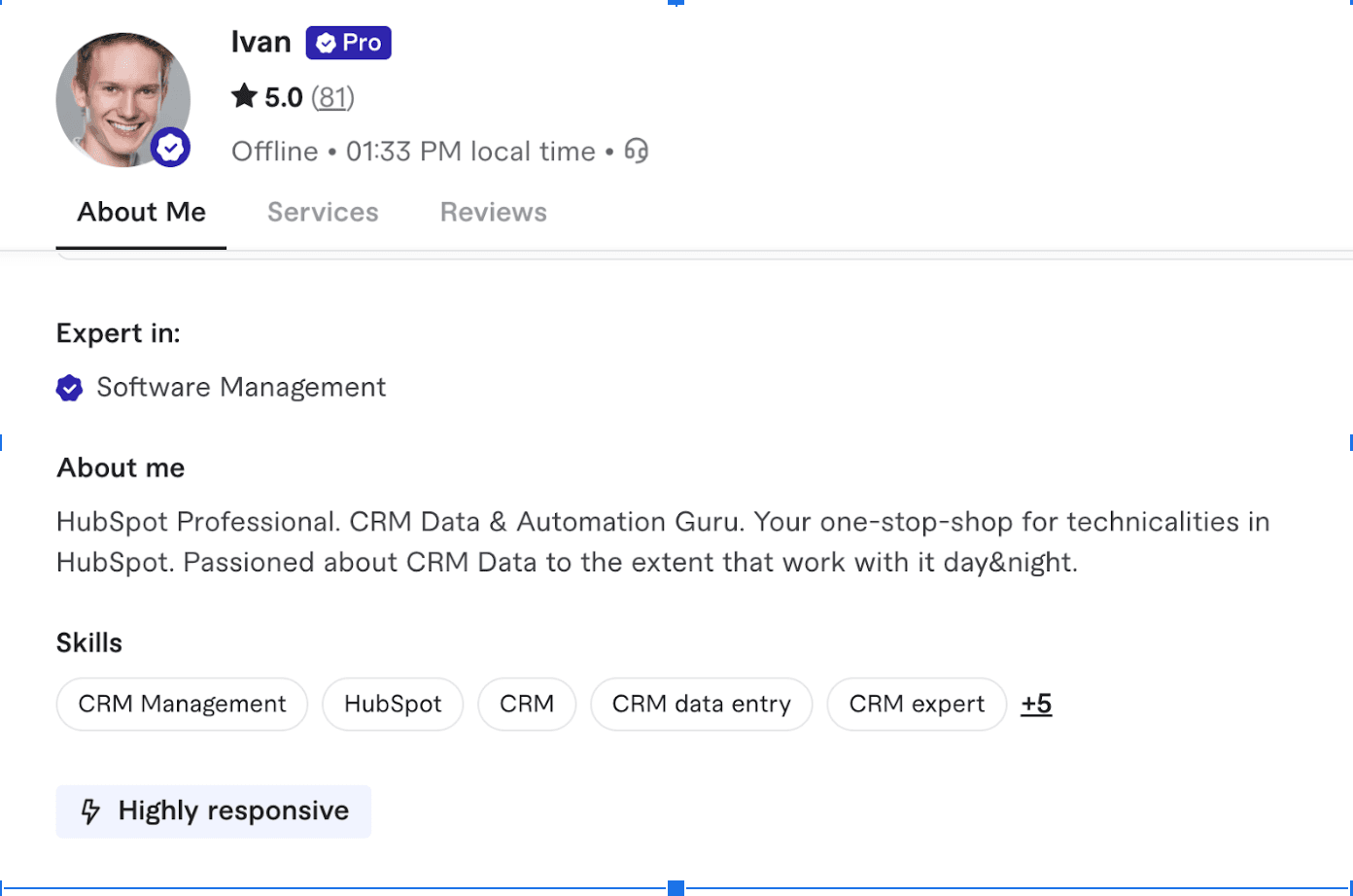
For example, if you’re in the middle of implementing a popular yet complex CRM system like HubSpot or Salesforce, hiring a virtual assistant with experience in that specific platform can help you set your team up for success. They can organize your data properly and train your salespeople without needing exclusive onboarding from the CRM provider.
5. Market Research
Virtual assistants are handy when entering new markets, launching new products, or just exploring fresh strategies. They can use their time and experience to dig into potential markets, prospects, and competitors, arming your sales team with the necessary data.
Here's what they may offer:
Research emerging markets or untapped segments that align with your product or service.
Gather detailed information on potential clients, from company size and industry trends to key decision-makers.
Analyze your competitors' strategies, strengths, and weaknesses.

Market research understandably requires more experience and time than basic back-office tasks. Costs can start as low as $50 and go up to several thousand dollars per project, depending on the scope.
6. Translation
Two-thirds of consumers would switch to a different brand that offers a native-language customer experience. If you’re targeting a global market and don’t have a multilingual team, you’d better bring in a virtual sales assistant who speaks the language of your key customer segments.
Depending on your needs, you can find a person who will:
Translate sales materials, emails, and presentations.
Conduct outreach and follow-up in the customer's native language.
Assist in multilingual meetings or calls to bridge language barriers.
Localize marketing content to resonate with specific regions.
Monitor and respond to customer inquiries in different languages across various platforms.

7. Social Media and Online Presence Management
Want to stay on top of your LinkedIn and other social media accounts without pulling your team away from their core tasks? Let a virtual assistant handle it.
Common tasks include:
Keeping an eye on mentions, comments, and messages across your social channels.
Responding to inquiries and engage in discussions on forums and social media groups.
Creating content that supports your sales and marketing strategies.
Running conversion-focused ads.

While social media management might not be a traditional sales task, it can indeed become a powerful channel for demand generation.
How to Hire the Perfect Virtual Sales Assistant
Now, let’s help you find the one who meets your needs.
1. Get a Grasp of Available Offers
You might think you need a virtual sales assistant to manage your chaotic lead data, but what you actually need could be someone who can streamline that data once and for all using a powerful CRM.
Or perhaps you’re searching for a contractor to handle customer conversations, when in reality, you just need someone to set up an AI-powered system to automate those interactions.
Before you even decide what you need a virtual assistant for, explore the options available on hiring platforms. You might find solutions that don’t just fill gaps but eliminate them entirely.
For example, with the rise of AI and automation services, many virtual assistants now offer expertise in developing or implementing AI-powered systems. Fiverr has a whole category dedicated to AI services. This might be a direction worth exploring.
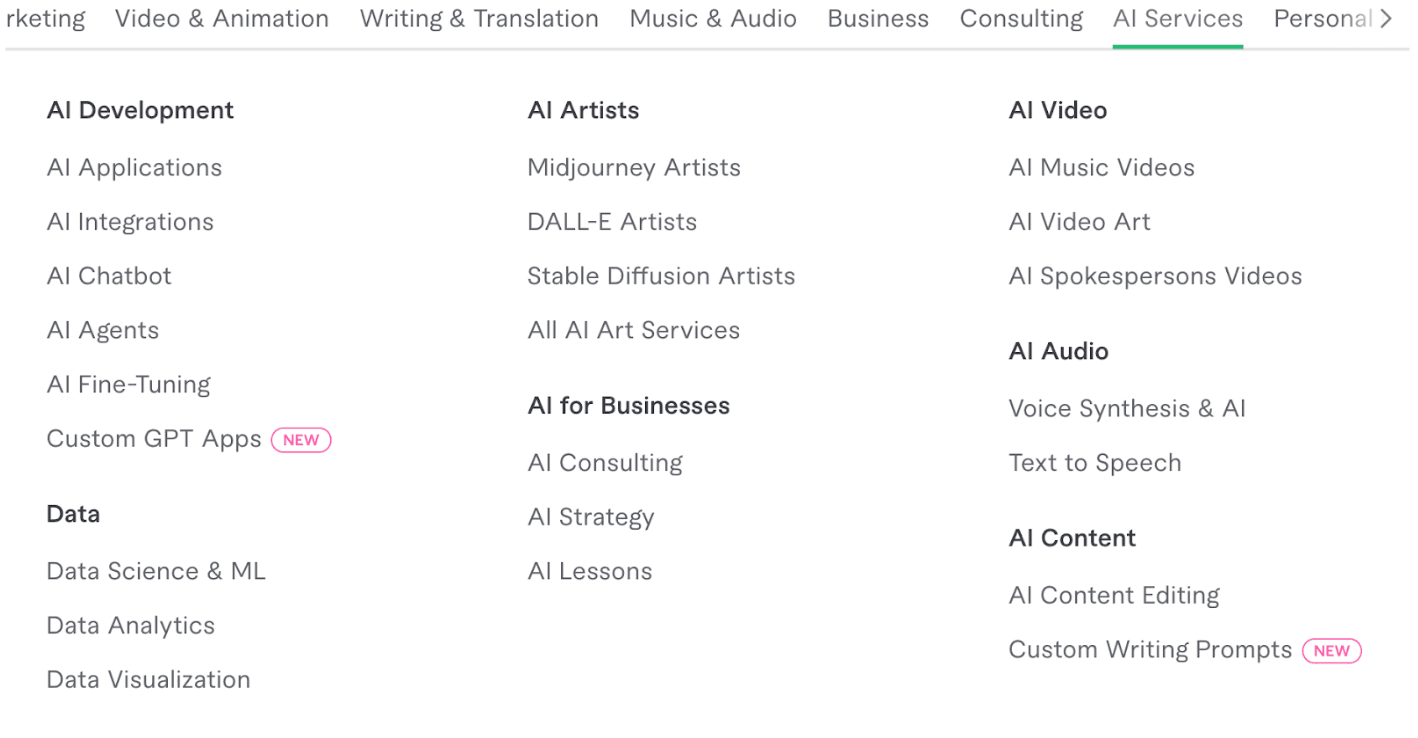
2. Define Your Needs
If you’re unsure about what exactly you need help with, now’s the time to figure it out.
Start by making a list of inefficiencies in your workflows and identifying what might be causing them. While a virtual assistant may not solve all your problems, delegating tasks that create bottlenecks can be a significant step in the right direction.
For instance, if you’re not scheduling enough product demos each month, ask yourself why. Is it because your sales reps are too busy handling other tasks, or are they struggling to get prospects to book those demos in the first place? The former issue could be solved by offloading administrative tasks, while the latter suggests you should probably focus particularly on bringing in more high-quality leads.
Once you’ve identified the tasks you want your assistant to handle, create a list of clear criteria and skills they should have. This may include:
Languages: What languages should they speak?
Time zone: Can they work within your preferred time zone?
Experience: Do they have specific experience and a proven track record with the tasks you need them to handle?
Industry and software knowledge: Are they familiar with your industry and the tools you use?
Budget: What’s your expected budget for the project?
Availability: Can they meet your project timeline?
Soft skills: Do they have strong communication skills and other relevant soft skills?
Now, you can begin your search.
3. Choose the Right Hiring Platform
It’s not so much about picking one specific platform but about choosing the right type of platform for your needs first. When looking for virtual assistant services, you’ve got three main options:
Freelance platforms are great if you want to browse through a wide variety of freelancers and choose based on their profiles, reviews, and rates. Websites like Upwork or Fiverr let you post a job, review applicants, and hire someone who fits your criteria. This option offers flexibility and a lot of choices but can be a bit of a DIY process.
Specialized virtual assistant staffing firms often have a vetted pool of candidates with specific skills. They can match you with someone who fits your exact needs and handle much of the legwork for you. If you’re looking for expertise and a more hands-off approach to finding your assistant, this might be the way to go.
Outsourcing agencies usually offer turnkey project management. Instead of handling individual contractors and assigning tasks yourself, you’ll have a single point of contact who oversees the work and ensures you get the results you need.
Which one is right for you?
Working directly with freelancers is usually the most affordable route. Going through specialized staffing firms costs a bit more, but you get added expertise and support. Outsourcing through an agency tends to be the priciest option, but it comes with full project management and a single point of contact to handle everything for you.
4. Run Tests and Interviews
Remember you’re hiring a virtual assistant, not an in-house employee. You won’t be able (or need) to go through multiple rounds of interviews or ask them to do a free test.
What you can and should do is the following:
Review their profile against the criteria we’ve mentioned above.
Find out if they’ve done similar tasks before.
Communicate with them directly to gauge their communication skills.
Run a paid trial project to see how they handle the work before committing long-term.
To vet your potential assistant’s skills, consider using talent assessment software. Tools like TestGorilla offer various skill-based tests that usually take between 10 and 35 minutes for candidates to complete. It’s not as involved as a paid trial project (which you can’t do anyway), but it’s a great way to get a solid sense of their abilities.
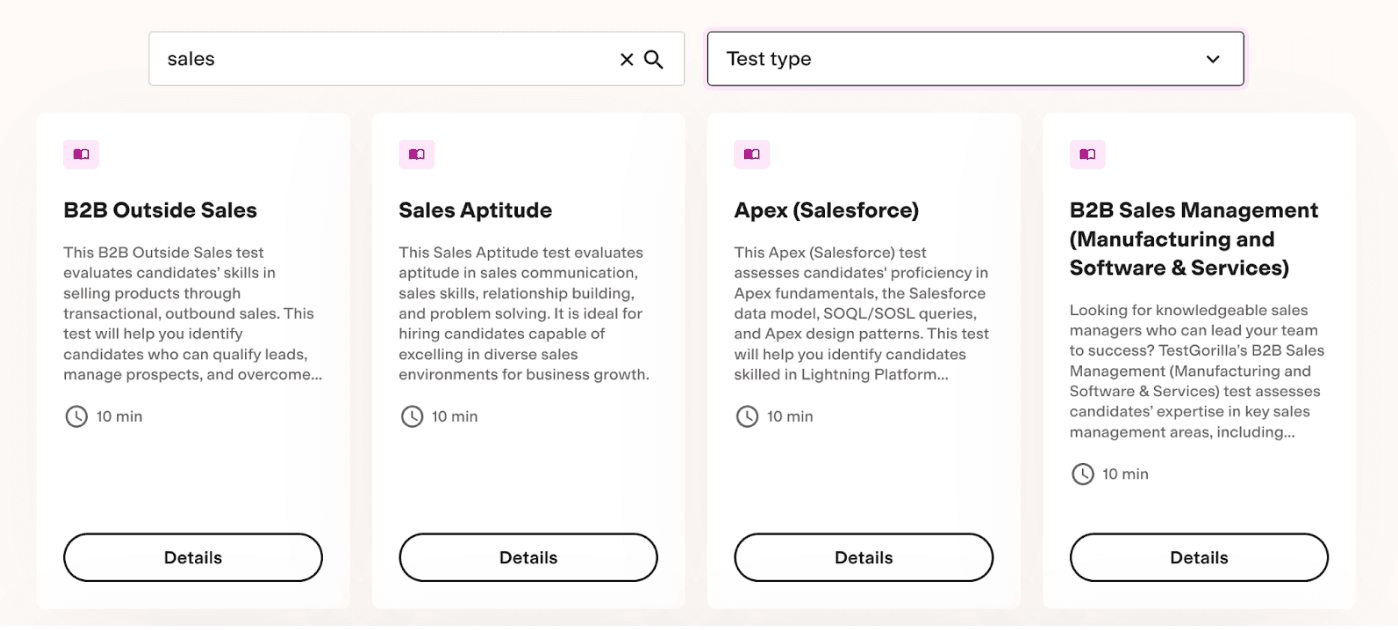
5. Integrate Them Into Your Workflows
Ready to hand over the reins and kick back? Not so fast.
To get the most out of your investment, equip your new assistant with everything they need to deliver their best work. This is a great place to start:
Share a detailed knowledge base or create specific documentation for the project.
Whether you’re using Slack, Microsoft Teams, or another tool, add them to the relevant channels and groups.
Grant them the right level of access to your tools and projects. Give them what they need to do their job effectively but restrict access to sensitive data or areas they shouldn’t see.
Set up a system to track their performance. Regularly review what they’re working on to ensure they’re meeting your goals and delivering the results you expect.
Bringing in a person who isn’t officially part of the team has its challenges. You can tell them what to do, but not how they should do it, which leaves you with little to no control over their methods.
To get the results you want, it's important to communicate clearly and share all the necessary details right from the start. This way, everyone knows what’s expected, and you can avoid surprises down the road.
Drive Growth Faster with an AI Virtual Sales Assistant
AI virtual sales assistants are becoming a popular alternative to their human counterparts. They can handle many of the same tasks—like following up with leads, scheduling meetings, managing customer relationships, etc.—but they do it faster, more efficiently, and they're available around the clock.
But the best part is that you maintain complete control over your AI virtual sales assistant. You can:
Access the data you need anytime, without waiting for a meeting.
Customize workflows exactly the way you want, without relying on someone else’s experience—or lack thereof.
Keep your company and client data secure without needing to involve a third party.
Step in and take control of the sales process whenever you choose.
With an AI virtual sales assistant, you get efficiency, flexibility, and peace of mind.

Ava, our AI SDR, will take over your outbound demand generation process without requiring extensive training or onboarding.
And because she’s powered by AI, Ava continually learns and adapts, becoming more effective the longer she works with your business.
Ready to see how Ava can assist you with outbound sales operations? Hire her today.
